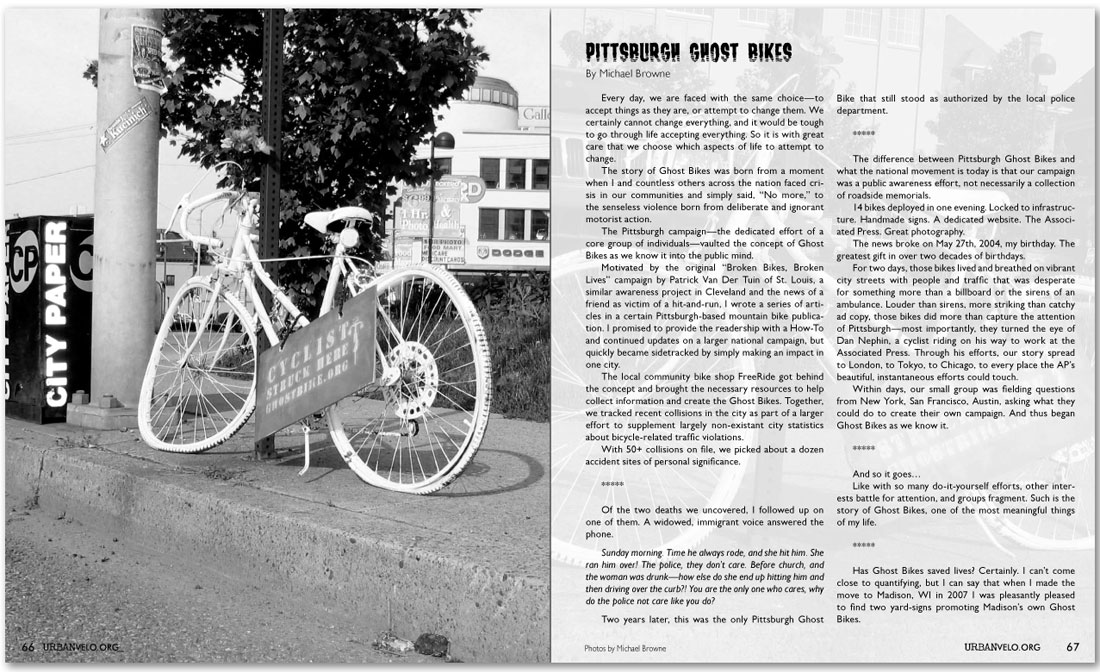

|
|||
Pittsburgh Ghost Bikes Every day, we are faced with the same choice—to accept things as they are, or attempt to change them. We certainly cannot change everything, and it would be tough to go through life accepting everything. So it is with great care that we choose which aspects of life to attempt to change. The story of Ghost Bikes was born from a moment when I and countless others across the nation faced crisis in our communities and simply said, “No more,” to the senseless violence born from deliberate and ignorant motorist action. The Pittsburgh campaign—the dedicated effort of a core group of individuals—vaulted the concept of Ghost Bikes as we know it into the public mind. Motivated by the original “Broken Bikes, Broken Lives” campaign by Patrick Van Der Tuin of St. Louis, a similar awareness project in Cleveland and the news of a friend as victim of a hit-and-run, I wrote a series of articles in a certain Pittsburgh-based mountain bike publication. I promised to provide the readership with a How-To and continued updates on a larger national campaign, but quickly became sidetracked by simply making an impact in one city. The local community bike shop FreeRide got behind the concept and brought the necessary resources to help collect information and create the Ghost Bikes. Together, we tracked recent collisions in the city as part of a larger effort to supplement largely non-existant city statistics about bicycle-related traffic violations. With 50+ collisions on file, we picked about a dozen accident sites of personal significance. ***** Of the two deaths we uncovered, I followed up on one of them. A widowed, immigrant voice answered the phone. Sunday morning. Time he always rode, and she hit him. She ran him over! The police, they don’t care. Before church, and the woman was drunk—how else do she end up hitting him and then driving over the curb?! You are the only one who cares, why do the police not care like you do? Two years later, this was the only Pittsburgh Ghost Bike that still stood as authorized by the local police department. ***** The difference between Pittsburgh Ghost Bikes and what the national movement is today is that our campaign was a public awareness effort, not necessarily a collection of roadside memorials. 14 bikes deployed in one evening. Locked to infrastructure. Handmade signs. A dedicated website. The Associated Press. Great photography. The news broke on May 27th, 2004, my birthday. The greatest gift in over two decades of birthdays. For two days, those bikes lived and breathed on vibrant city streets with people and traffic that was desperate for something more than a billboard or the sirens of an ambulance. Louder than sirens, more striking than catchy ad copy, those bikes did more than capture the attention of Pittsburgh—most importantly, they turned the eye of Dan Nephin, a cyclist riding on his way to work at the Associated Press. Through his efforts, our story spread to London, to Tokyo, to Chicago, to every place the AP’s beautiful, instantaneous efforts could touch. Within days, our small group was fielding questions from New York, San Francisco, Austin, asking what they could do to create their own campaign. And thus began Ghost Bikes as we know it. ***** And so it goes… Like with so many do-it-yourself efforts, other interests battle for attention, and groups fragment. Such is the story of Ghost Bikes, one of the most meaningful things of my life. ***** Has Ghost Bikes saved lives? Certainly. I can’t come close to quantifying, but I can say that when I made the move to Madison, WI in 2007 I was pleasantly pleased to find two yard-signs promoting Madison’s own Ghost Bikes. |
Photos by Michael Browne |
|
|